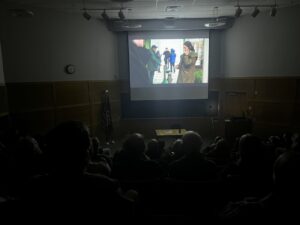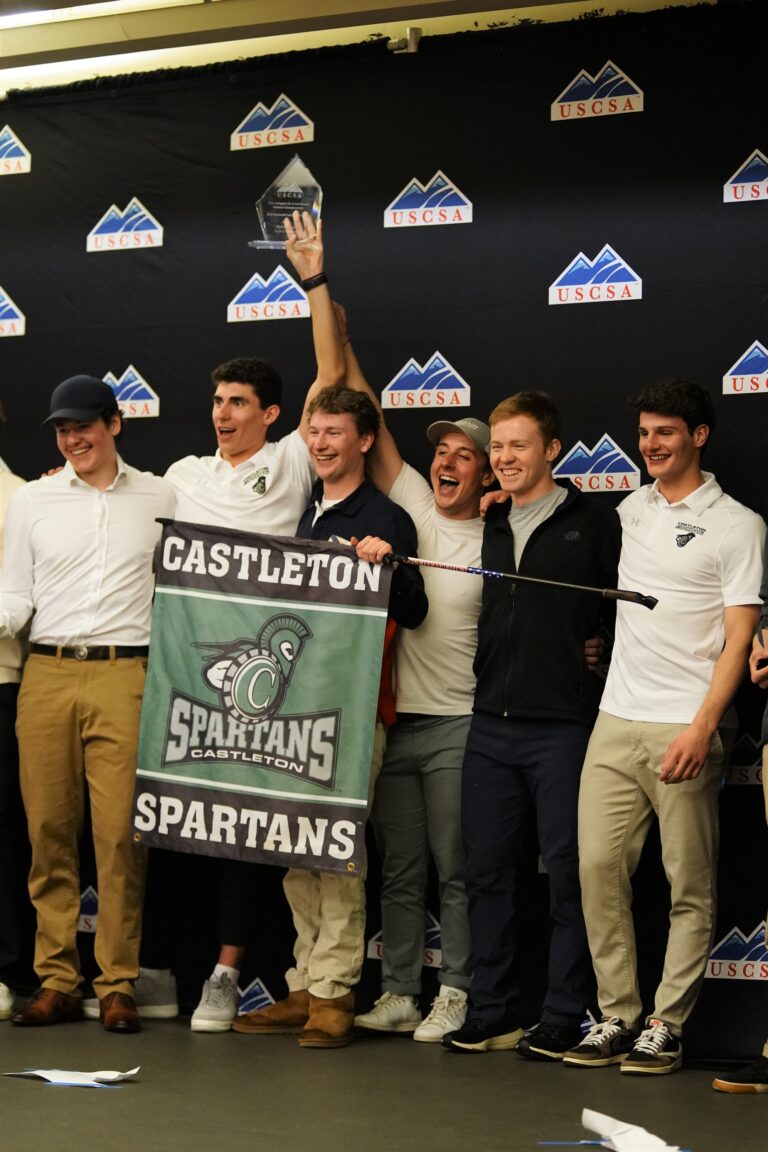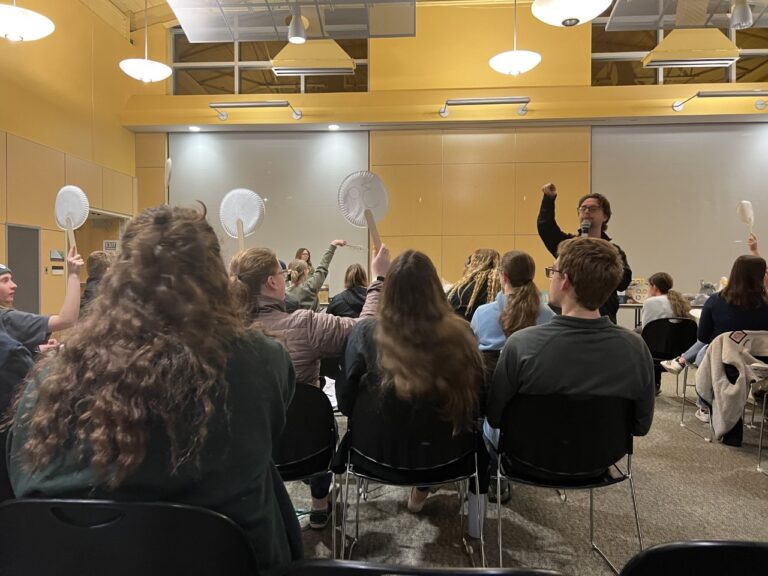Films from abroad – Annual International Film Festival draws large crowds

When I went to Herrick Auditorium on a Thursday night earlier this month, it was the first time I had sat down to watch a film in a darkened room surrounded by relative strangers since before the pandemic.
Especially in our post-pandemic age, but also due to the dominance of streaming services, it seems that this deeply human way of experiencing cinema is becoming more and more remote. For me, attending Castleton University’s International Film Festival was a refreshing return to a way of seeing movies that I had almost forgotten how much I needed.
Community members were catching up on each other’s lives, and students were discussing classes and cracking jokes, and when the lights went down, there was laughter, “ooos,” “ahhhs,” and, occasionally, “huhs?” I enjoyed the return to this kind of atmosphere almost as much as I enjoyed the film.
English professor Burnham Holmes, who has taught writing and speech at Castleton for 19 years, seemed to be enjoying the atmosphere.
“Even if people aren’t saying anything,” he said of watching films in this environment, “you still know they’re there, you feel some kind of energy.”
The International Film Festival has been happening every spring at Castleton for nine years now. It was originally introduced by Professor Michael Talbott, associate professor and chair of the Media and Communication department.
Now, Sam Davis-Boyd, assistant professor of Media and Communication, is leading the festival with the support of Talbott and Marisa Valent-Altland, director of the Fine Arts Center and Soundings coordinator.
The festival screens four international films over the course of two weeks. Davis-Boyd selected the films and chose the theme: women in film, with a focus particularly on films directed by women that tell women’s stories.
The films shown this semester included “Aloners” (2021), a South Korean film about a woman who isolates herself from everyone around her, “The Hill Where Lionesses Roar” (2021), a film made in Kosovo about a group of young women who, dissatisfied with their small-town life and decide to start a gang, “Sirens” (2022), a documentary about the only all-female heavy metal band in Lebanon and “Honeyland” (2019), a documentary about a woman in Macedonia who keeps bees.
As of the writing of this article, I have attended the screenings of two of the four films: “The Hill Where Lionesses Roar” and “Sirens.” I spoke to Valent-Altland briefly before one of the screenings I attended and asked her how she was feeling about the event.
“I’m really excited about it. I’m excited that the Soundings department gets to collaborate with the communications department. I’m thrilled with the films that Sam Davis-Boyd has picked. She has excellent taste in films,” Valent-Altland said. “I think everybody’s having a great time, I’m having a great time, and I’m glad that we get the chance to share this every year.”
I also found myself having a great time, and I really enjoyed both films, finding them thought-provoking and exciting in different ways. I was eager to talk to Davis-Boyd about the films and how and why she chose them.

During our conversation, Davis-Boyd discussed the fact that most films are made by older people, white people and men.
“That’s Hollywood – that’s been Hollywood,” she said.
By contrast, Davis-Boyd was enthusiastic about the director of “The Hill Where Lionesses Roar,” Luana Bajrami. Bajrami was just 18 when she wrote the film, and 19 during its production. The film has won several prestigious awards and was screened at the famous Cannes Film Festival.
“I think it’s really encouraging and empowering to see somebody so young make such an acclaimed film at such a young age. I think it speaks to all of the awesome things that young people are capable of and are doing, so I thought students would connect with that. I connect with it, and I’m much older,” she said.
She also talked about the theme of women in film overall, and what led her to choose it.
“This has been a subject of discussion in light of the #MeToo movement: representation of women on screen, and not just on screen but behind [the] screen,” Davis-Boyd said. “Women’s bodies and voices are very often the subject of discussion in films, they have been for a long time, but looking at who’s making those films and the perspective that those are coming from looks a very certain way. I think we all know what that looks like. For me, it was about highlighting, yes, films about women, but [also] films made by women.”
Talbott spoke about the origin of the festival, and the importance of its international focus. He talked about his love of film festivals, starting when he was attending San Francisco State University and went to the San Francisco International Film Festival. He described it as a “really transformational experience,” and it led him to becoming interested in film from parts of the world that he “hadn’t even thought about before.”
“Films, especially films from faraway places – films we wouldn’t encounter in our daily habits of seeking out entertainment – can often be windows into places we couldn’t go otherwise and allow us to see people’s experiences that we couldn’t possibly know anything about,” Talbott said.
Davis-Boyd, Talbott and Valent-Altland all spoke about the aspect of the festival that had so positively impacted attendees: enjoying cinema as a communal experience and as an opportunity for connection with others.
“I think they’re remembering that we’re here, and we’re glad that they’re remembering,” Valent-Altland said of the large numbers of community members that have been attending the screenings this semester.
Talbott told me that he was “so excited” to see that there were people from Castleton and Rutland who came to all the screenings and wanted to talk about them.
“The one thing they said was, ‘These movies are available on Netflix, I could just stream them at home, but that’s not nearly as interesting as coming here and watching them with other people and then hearing faculty members talk about them and hearing people ask questions and aspects of the movie being discussed,’” Talbott said. “When we talk about cinema being born, it’s not the first time people discovered moving images, it’s the first time they showed them on a screen in a room full of people.”
“Being in the room with everybody and hearing their reactions is my favorite part of a festival,” Davis-Boyd said of the atmosphere at the events. “How many of us have gone to the movie theaters recently?”
Asked about the future of the festival and if she has any sense of what next year’s theme will be, Davis-Boyd said she isn’t sure yet but that she has got lots of ideas, such as highlighting indigenous voices, trans and non-binary cinema or a focus on films that are coming out of Asia.
With the Vermont State University merger set to take effect this summer, however, she isn’t certain at the moment what exactly the future of the International Film Festival will look like. Though she expects it to continue.
What is certain is Davis-Boyd and her colleagues’ enthusiasm for the project, and, judging from the packed houses and vibrant discussions, the Castleton community shares this excitement, too.
As for the future of the International Film Festival, Talbott feels strongly about it continuing.
“I really like that someone else has been doing the programming, and I hope that we can continue to do that, that Sam will collaborate with others, that I may collaborate with her again. The film festival should be a living organism that grows and transforms over time,” he said.








